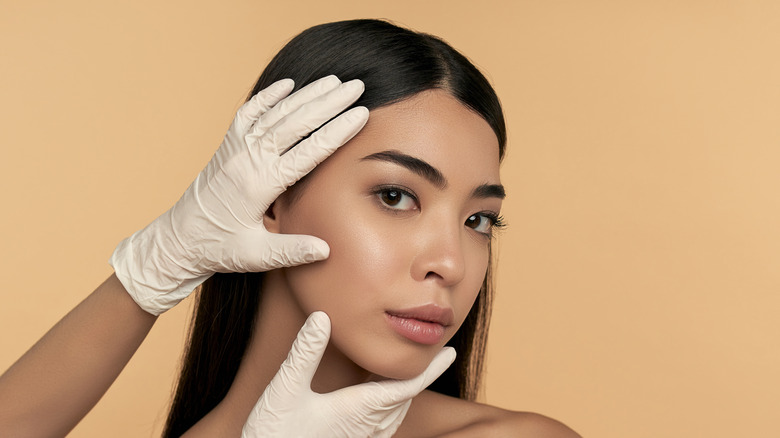How Often Should You Expect To Get Dermal Fillers? The Answer May Vary
After decades of stigma surrounding the use of facial fillers, the procedure is steadily climbing in popularity, garnering honest conversations around the topic. More women are comfortable sharing the types of fillers they've received, dispelling misinformation, and educating more people on the purpose behind getting dermal fillers.
While there's not always a shared reason for the uptick in getting fillers — nor is it anybody's business on why somebody has made that choice — the transparency has helped women feel more comfortable learning about the procedures and making the leap to get them in the first place. Injected around the eyes, nose, or mouth area, dermal fillers serve to smooth out fine lines and wrinkles around the face.
Various types of dermal filler can be used, such as hyaluronic acid fillers or Bellafill. The standard for how long dermal fillers last is about six to 12 months. Yet, with each filler consisting of different materials, some last for a shorter amount of time while others can stay intact for much longer.
Different types of filler and their longevity
One of the more popular dermal fillers, Juvederm, is a hyaluronic-based filler. There are several types of Juvederm fillers, targeted towards different areas of the face. While Juvederm Voluma XC increases the volume of your cheeks, Juvederm XC and Juvederm Vollure XC work to plump up wrinkles and lines around your nose and mouth while enhancing skin elasticity. Juvederm Voluma can last you up to two years with a touch-up around the halfway point. However, Juvederm Vollure will last anywhere from 12 to 18 months.
Unlike hyaluronic acid fillers, Poly-L-lactic acid fillers aren't made from naturally-occuring substances. A stimulator, they help your body to produce more collagen. With these fillers, it typically takes about three treatments over the span of three months to see results. Despite this, the dissolvable fillers are long-lasting, staying up to two years.
Probably one of the longest-lasting dermal fillers on the market, Bellafill's polymethyl methacrylate (PMMA) microspheres can stay up to five years. Like Poly-L-lactic acid fillers, they also increase collagen production in the skin, helping with volume loss, wrinkles, fine lines, and even acne scars. To maintain results, a touch-up may be required after a year or two.
What type of dermal filler is best for you?
Before you call up the plastic surgeon's office to book a filler appointment, take time to research your options to see which dermal filler is right for you. Knowing exactly what you want to target will help you know what type of filler to choose. Whether you have questions about under-eye fillers or cheek fillers, examine all of your options carefully. If you're new to getting fillers, it's recommended to start with hyaluronic acid fillers. They are easy to dissolve — another process worth reading about, as it could produce unwanted side effects.
For people who are seasoned filler veterans and don't like to constantly get injectables, Bellafill may be the right type of derma filler for you. However, in order to get it, a consultation where you're examined for nasolabial folds – what the filler was created for — is vital before getting them.
Like any cosmetic procedure, fillers also come with their own share of side effects. Some common ones are bruising, pain, redness, tenderness, swelling, and itching that occur after injection. While this is rare, there's also a risk that the filler may enter a blood vessel and cause a stroke or permanent blindness. You should get an allergy test to see if you're allergic to any of the materials used in your fillers, as well.


